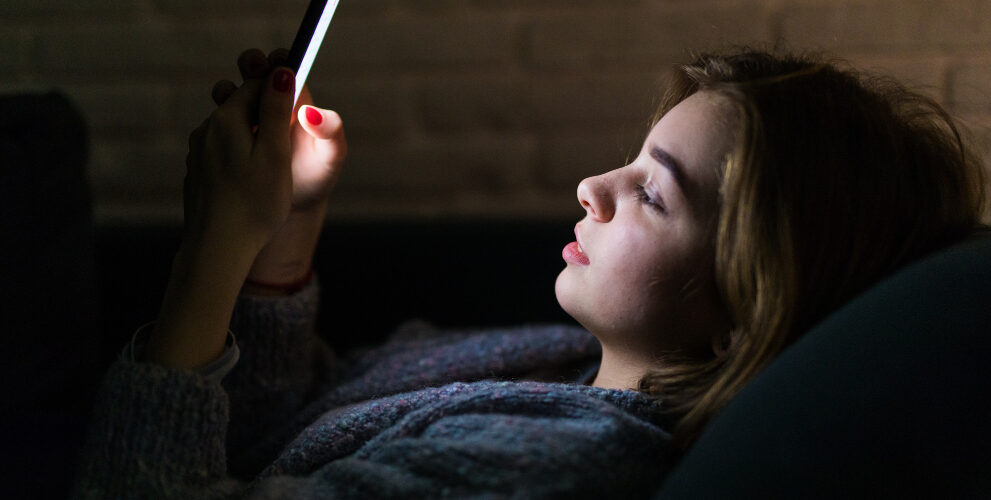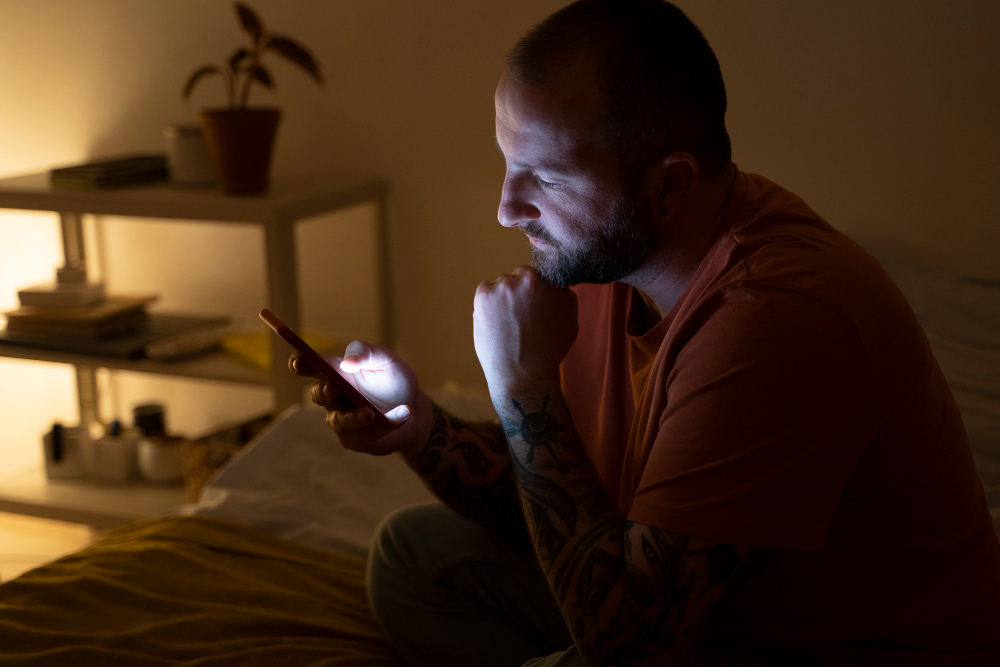Latest
The hidden cost of late-night scrolling: Understanding and preventing Computer Vision Syndrome
Late-night scrolling and poor digital habits lead to symptoms like dry eyes, blurred vision, headaches, and even temporary blindness. Globally, nearly 60 million people are believed to suffer from Computer Vision Syndrome
Author
Author
- admin / 1 month

- 0
- 10 min read

Author
It is midnight. The lights are off, the world outside is quiet, and the bed feels warm and comforting. Yet, instead of drifting into sleep, your hand reaches out for your smartphone or computer. The glow of the screen fills the room as you scroll through Instagram reels, binge-watch the latest series on an OTT platform, or mindlessly browse.
The habit is almost universal, a guilty pleasure of sorts, something we tell ourselves will last only five minutes but easily stretches into hours. What often goes unnoticed in these moments of indulgence is the strain silently building on our eyes.
With increased screen exposure, doctors now warn that such habits, especially scrolling in the dark, can lead to Computer Vision Syndrome (CVS), a condition that can trigger temporary or even permanent vision problems. Globally, nearly 60 million people are believed to suffer from Computer Vision Syndrome (CVS).
The problem isn’t confined to computers in offices anymore, but extends to the devices we carry everywhere — smartphones, tablets, and e-readers. Smartphone Vision Syndrome is often regarded as a modern offshoot of this condition, and it is also called digital eye strain.
What is Computer Vision Syndrome (CVS)?
Computer Vision Syndrome refers to a set of vision problems that arise when people use digital devices for long hours. Our eyes are not naturally equipped to handle the challenges posed by screens. The text we read on them is not solid, as in books or printed material, but made up of pixels that lack sharp edges and contrast. To make sense of this, the eyes constantly refocus and adjust, creating strain over time. In the short term, the condition may manifest as discomfort, but if left unaddressed, it can seriously impact productivity, quality of life, and, in extreme cases, vision itself.

In fact, a 2021 case study drew attention to the more unusual but alarming effects of smartphone use. A woman in her thirties was referred to a stroke clinic on suspicion of recurring amaurosis fugax, or transient vision loss.
Her ophthalmic and neurological examinations were normal, but a closer history revealed that her symptoms occurred when she used her smartphone in bed, typically while lying on her left side with her left eye covered by a pillow. Once she looked away from the bright smartphone screen in the otherwise dark bedroom, she noticed a temporary loss of vision in her right eye. Doctors concluded she was experiencing “transient smartphone blindness,” a phenomenon where one eye adapts to darkness while the other, exposed to screen light, struggles to adjust, creating the illusion of temporary blindness.
A 30-year-old almost lost her eyesight to screens in Hyderabad
In India too, the danger became alarmingly real in Hyderabad, when a young woman almost lost her eyesight because of her nightly scrolling routine. Dr Sudhir Kumar, a neurologist in the city, took to ‘X’ to share her story. He said that 30-year-old Manju suffered from disabling vision problems for over a year — including floaters, bright flashes, zigzag patterns, and at times complete loss of sight for a few seconds, especially at night.
Eye tests showed nothing unusual, but Dr Kumar discovered that after quitting her job to care for her specially-abled child, Manju had developed a habit of using her smartphone for hours daily, often late at night with the lights off.
He diagnosed her with Smartphone Vision Syndrome (SVS), part of the broader Computer Vision Syndrome caused by prolonged digital use. Instead of medicines, he simply advised her to cut down screen time. Determined, Manju stopped using her phone recreationally, and within a month, her vision returned to normal. The floaters and flashes disappeared, and her nighttime vision loss ended — confirming that her smartphone use was the culprit.
What are the causes and symptoms of CVS?
As established, the causes of CVS or SVS are tied closely to how we interact with our devices. Research suggests that even two hours of continuous screen use is enough to trigger symptoms, and with smartphones, the hours often stretch much longer.
Unlike reading a book, where the text is stable and sharp, the digital screen constantly demands adjustments. Every word, every image, is built of pixels, and the eyes are forced to focus and refocus repeatedly. The lack of contrast between text and background makes this process even harder.
Compounding the problem is the drastic reduction in blinking. Ordinarily, humans blink around 18 to 22 times a minute, which keeps the eyes lubricated. In front of a screen, that number drops to as few as three to seven blinks per minute, often incomplete, leading to dryness and irritation.
Lighting plays a crucial role, too. Using smartphones in dark rooms, as in Manju’s case, places the eyes under extraordinary strain. The sharp contrast between the bright glow of the screen and the surrounding darkness forces constant adjustment. The habit of holding devices at awkward angles and leaning forward further adds musculoskeletal strain. Over time, these habits create a cycle of discomfort that builds slowly, often unnoticed, until the symptoms become disruptive.
The symptoms of this condition are diverse and can affect people in ways they do not immediately connect to their screen use. The most common complaint is eye discomfort, often described as dryness, itching, burning, watering, or the sensation that something is lodged in the eye.
Blurred vision that comes and goes is also frequent, especially when shifting focus from near to far distances or vice versa. Bright lights may suddenly feel overwhelming, making people more sensitive to glare. Headaches, particularly behind or around the eyes, become routine, while fatigue can make it difficult to keep the eyes open. In some severe cases, visual disturbances such as flashes of light or floating shapes may appear, creating fear of more serious underlying issues.
Importantly, digital eye strain is not limited to the eyes. Long hours spent hunched over a screen, with poor posture and little movement, often lead to neck, shoulder, and back pain, turning it into a full-body strain disorder.
The relevance of this issue cannot be overstated. The modern lifestyle revolves around screens. Work meetings, education, entertainment, social connections, shopping, and even relaxation are mediated through digital devices.
A descriptive cross-sectional study conducted among 112 university students in Hyderabad in late 2024 found that symptoms of digital eye strain were nearly universal. The mean age of participants was just over 22 years, and while every single student owned a smartphone, nearly two-thirds also owned laptops. The most common complaints were headaches, affecting 75 per cent of the students, followed by burning or itching in the eyes (50 per cent) and watering eyes (49.1 per cent). The researchers observed that screen time had significantly increased over the preceding three years, reinforcing the need for preventive measures and awareness programmes to address what is fast emerging as a major public health concern.
How to avoid and treat CVS?
Dr Nusrat Bukhari, Ophthalmologist at Apollo Spectra in Tardeo, Mumbai, explained that prolonged screen use has far-reaching consequences: “Anything in excess, if stretched to multiple hours a day, will definitely lead to damage. Initially, it may start with dry eyes, irritation, redness, or watering. But over time, patients often develop a habit of rubbing their eyes to relieve discomfort, and that constant rubbing can trigger refractive errors like astigmatism.”
She noted that many patients begin with surface-level eye issues but eventually complain of blurred vision. “When we investigate such cases, we often find newly developed refractive errors. In a city like Mumbai, where allergies are common, dryness from long screen use only worsens sensitivity, making patients rub their eyes more and unknowingly damaging their vision,” Dr Bukhari added.
According to her, cases of Computer Vision Syndrome (CVS) rose sharply after COVID-19 and have not slowed down since. With work, education, and entertainment shifting almost entirely to screens during the pandemic, people developed habits of extended device use that continue to persist today. “The numbers just keep rising,” she observed.
In fact, a meta-analysis, covering 45 studies conducted between December 2021 and April 2022, also confirmed that two in three participants suffered from computer vision syndrome. Interestingly, prevalence varied widely across regions, ranging from 97 per cent in Pakistan to just 12 per cent in Japan. The review noted that differences in study settings, screen usage habits, socioeconomic backgrounds, and diagnostic methods contributed to this variation. For instance, in India, studies conducted before the COVID-19 lockdown reported a prevalence of 64.3 per cent, which surged to 87.3 per cent during the lockdown, when digital dependence was at its peak. The review emphasised that factors such as poor lighting, uncorrected vision problems, long hours of continuous screen use, and close eye-screen distances were consistently linked to higher rates of CVS.
Dr Bukhari explained that using smartphones in the dark is particularly harmful because, in dim light, the pupils dilate naturally to allow more light to enter. When a bright phone screen is introduced in such conditions, an excessive amount of light rays floods the eye, putting immense strain on the visual system. This is why reading or scrolling in the dark places extraordinary stress on the eyes. She also advised that reading or using digital devices should be done in a well-lit environment, as this reduces the strain on the eyes and makes text clearer and more comfortable to read.
A systematic review conducted in 2022 retrieved 725 studies, of which 49 were included. The pooled prevalence of CVS was calculated to be 66 per cent, meaning nearly two in three participants across the reviewed studies were affected. The review also identified key risk factors: women were more likely to report CVS, as were people who maintained improper postures, used electronic devices outside of work, failed to take regular breaks, spent long hours at visual display terminals, and held screens at short distances. In contrast, good awareness and ergonomic practices were linked to reduced odds of developing symptoms.
“Our head already carries significant weight, and when tilted forward for long periods, that weight translates into enormous strain on the neck, shoulders, and spine. It’s like forcing your body to carry an extra 15–20 kilos unnecessarily,” she explained.
For treatment, Dr Bukhari emphasised lifestyle changes: “Adequate breaks, reducing screen time, and correcting even minimal refractive errors are crucial. Allergies and dryness must be treated, and in some cases, eye exercises or special prisms in glasses may be needed. But it’s vital to consult a qualified ophthalmologist, not just a spectacle vendor. Many people in India rely on local opticians, but they may miss serious conditions like cataracts or internal eye diseases. A thorough eye check-up by a doctor, at least once a year, is essential.”
Also read: FACT CHECK: Does using a computer on lap affect male fertility?










